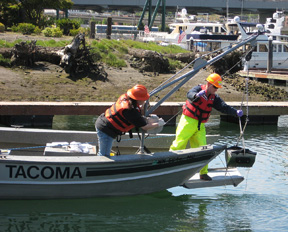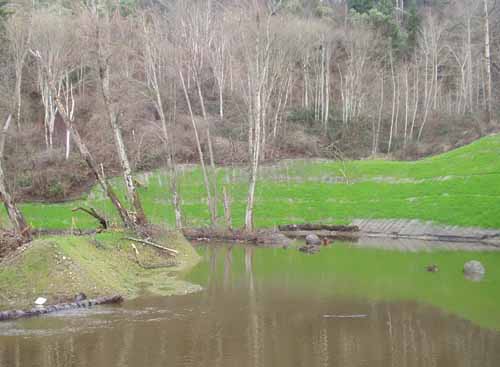The Thea Foss and Wheeler-Osgood waterways sparkle with new life today, thanks to a historic cleanup led by the City of Tacoma. The City removed or capped in place sediments contaminated by more than a century of environmentally insensitive practices and restored marine habitats around the Foss and other areas of Commencement Bay in partnership with agencies, organizations, property owners and other responsible parties.
Since the cleanup was completed in 2006, the focus has been on keeping the waterway clean.
In September 2022, the City of Tacoma premiered "Turning the Tide", a feature-length documentary film about this historic cleanup and revitalization of the Thea Foss Waterway. Click here to watch Turning the Tide.
Learn More About This Historic Project
 More Than 100 Years of Contamination
More Than 100 Years of Contamination
In 1983, the Environmental Protection Agency identified the Thea Foss and Wheeler-Osgood waterways as part of the larger 12-acre Commencement Bay Superfund site.
These waterways have been the site of industry for more than 100 years. The City of Tacoma literally grew up from the waterfront, where the deep-water port and western terminus of the Northern Pacific Railroad attracted businesses and the employees to work them.
Back then, industries dumped waste into the waterway and sewers emptied right into the bay. People viewed the ocean as a kind of washing machine; they believed the tides carried the waste away. We know now that isn't the way it worked -- the pollutants bonded with the sediments and settled into the waterways. This historical practice led to the accumulation of more than 1 million cubic yards of contaminated sediments.
The City and the EPA found the following chemicals polluting the sediment in the waterways:
%20-%20copy.GIF) How the Cleanup Was Accomplished
How the Cleanup Was Accomplished
In 1994, the City of Tacoma volunteered to take the lead in developing a cleanup plan for the Thea Foss and Wheeler-Osgood waterways.
The City aggressively investigated the sources and extent of contamination in the waterways. Investigation efforts included taking hundreds of sediment samples throughout the Foss from various depths and running those samples through extensive chemical and biological tests. Based on the results of those tests, along with current and anticipated navigational uses of the waterway, cleanup options were developed.
Under a plan accepted by the EPA, the City cleaned up 80 percent of the Foss -- an area extending from near the SR 509 Bridge to the mouth of the waterway. This area also includes the small Wheeler-Osgood Waterway. A group of private companies -- Puget Sound Energy and PacifiCorp -- cleaned up the other 20 percent, an area extending just north of the SR 509 Bridge to the head of the waterway.
 From 2002 to 2006, about 425,000 cubic yards of contaminated sediments were dredged from the waterways and placed behind a containment berm in the nearby St. Paul Waterway. This waterway was made available to the City for use as a nearshore disposal facility in a partnership agreement with Simpson Tacoma Kraft. That land is now available for Simpson to develop in a careful, appropriate way. Other areas of the Thea Foss Waterway were capped with clean sediments to contain some of the contamination in place.
From 2002 to 2006, about 425,000 cubic yards of contaminated sediments were dredged from the waterways and placed behind a containment berm in the nearby St. Paul Waterway. This waterway was made available to the City for use as a nearshore disposal facility in a partnership agreement with Simpson Tacoma Kraft. That land is now available for Simpson to develop in a careful, appropriate way. Other areas of the Thea Foss Waterway were capped with clean sediments to contain some of the contamination in place.
As part of the cleanup project, habitat restoration sites were constructed at four new locations: the Middle Waterway Tideflats Habitat, North Beach Habitat, Puyallup River Side Channel and Hylebos Creek mitigation site. In addition, shorelines were enhanced wherever possible to make them habitat friendly, including four additional areas along the Thea Foss Waterway.
Paying for the Cleanup
The cleanup bill added up to about $105 million. Here's how the cost was shared:
.gif)
- City of Tacoma's surface water rates - $56.5 million
- Washington State Department of Ecology grants - $24.5 million
- Private contributions from other responsible parties - $13 million
- PacifiCorp and Puget Sound Energy - $7.3 million
- Washington State Department of Natural Resources - $3.7 million
Keeping the Waterways Clean
A significant investment has been made in the cleanup of these waterways and in the Commencement Bay community through this remediation project. Stormwater from more than 6,000 acres in the City of Tacoma drains untreated to this waterway. To manage this potential source of contaminants, the City has been employing
source control efforts for many years. Keeping the waterways clean is an ongoing community effort.
The City developed an Institutional Controls Plan to outline what needs to be done to protect the cleanup. For example:
- Land owners have agreed not to do things on their property that could harm the shoreline areas.
- New construction in the waterway will be done carefully to ensure that capped contamination in the waterway is not disturbed.
- City staff and the Washington State Department of Ecology continue to monitor potential sources of contamination.
Monitoring the Waterway
The City monitors the waterway remediation through chemical monitoring, visual observations, and underwater surveys. In addition, the City monitors the habitat mitigation sites to make sure they function as intended. For current monitoring information view the most recent Thea Foss Operations, Maintenance and Monitoring Plan (OMMP) Annual Report.
The City monitors storm drains by testing the water and sediments regularly for possible contaminants. If contaminants are found, source tracing is done to try to determine the source. Many contaminants that enter the waterways, however, are untraceable. This "nonpoint" source pollution comes mostly from stormwater runoff, soapy water, oil and fertilizers which travel from residential areas through the City's 18,000 storm drains and 500 miles of pipes. For current monitoring information view the most recent Stormwater Source Control Report.
Tests performed by outside environmental engineers on the waterway and its contamination sources show that the water flowing through City storm drains is as clean or cleaner than comparable cities. Through an effective source control program -- inspections, storm drain maintenance and public education -- the City has significantly reduced surface water pollutants in the past 15 years.
Through our combined efforts, we can enjoy a clean and healthy environment for generations to come. Learn how you affect water quality and how you can help.